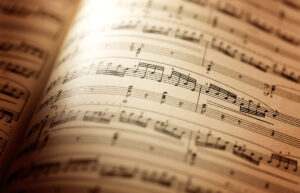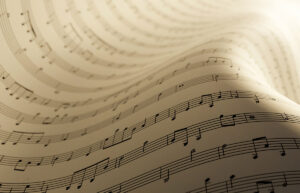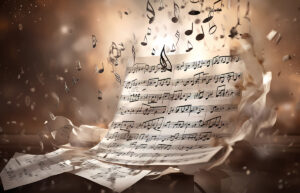How to Read Drum Music: Meaning, Symbols, Components, Tips & More

Welcome to the rhythmic realm of drum music! Whether you’re a novice or an aspiring percussionist, unlocking the secrets behind those mysterious musical symbols is your gateway to mastering beats and grooves. Imagine drum sheet music as a treasure map, guiding you through a captivating journey of patterns, accents, and rhythms. In this interactive guide, we’ll unravel the language of drum notation together, empowering you to decipher these intricate musical codes and transform them into dynamic, toe-tapping rhythms at your fingertips. Get ready to pick up your sticks and learn how to read drum music.
Welcome to TheDemoStop, now join the community!
Connect with artists, fans and producers around the world.
What is drum notation?
Drum notation is a symbolic language employed in sheet music to convey the specific patterns, rhythms, and techniques associated with playing drums and percussion instruments. In this system, various symbols, shapes, and placements on a single-line staff represent distinct drum sounds, including hits on the snare drum, bass drum kicks, cymbal strikes, and toms.
Drummers use this notation to interpret musical composition accurately, enabling them to reproduce diverse rhythms and beats precisely. Understanding drum notation is fundamental for effective communication and collaboration among musicians, ensuring a cohesive and synchronized performance within an ensemble or while playing with recorded music.
Importance of drum music sheet
Drum music sheets play a crucial role for drummers, offering precise guidance to replicate rhythms, beats, and nuances accurately. Acting as a common language, they preserve a composer’s intentions and provide beginners with a structured way to learn how to read drum music. For experienced drummers, they offer a framework for creative improvisation.
Moreover, drum music sheets promote synchronization in ensembles, ensuring cohesive musical performances where everyone plays in harmony. These notations are indispensable tools that enhance understanding, communication, and execution of percussive elements across various musical contexts.
Symbols of drum notes for different drums
In order to learn how to read drum music, it’s important to know the symbols of drum notes to have a better understanding.
Bass drum
In drum notation, the bass drum pedal’s strike is typically represented by a filled-in circle at the staff’s bottom. This symbol, often accompanied by the letter “B” or “BD,” indicates a low, resonant sound that serves as a rhythmic anchor in many musical pieces.
Floor Tom
Depicted by a note placed on the fourth space of the staff or sometimes indicated slightly above or below, resembling an open circle. This symbol signifies striking the floor to a larger drum placed on the floor. Known for its deep, booming sound, the floor tom is usually denoted by the letter “FT” or “F Tom” near the note.
Tom 1 and Tom 2
Both tom drums (higher and lower in pitch) are represented by notes on the spaces above the staff. Tom 1 (higher pitch) is notated as an open circle placed on the second space above the staff, while Tom 2 (lower pitch) is indicated as an open circle on the first space above the staff. These symbols portray striking the respective tom drums, often labeled “T1” and “T2,” alongside the notes.
Snare drum
Displayed as an ‘X’ on the second space of the staff or sometimes on ledger lines above or below. This symbolizes hitting the snare drum, known for its sharp, staccato sound created by the snares stretched across the drum’s bottom head. It’s usually labeled with “SD” or “SN” near the note.
Hi-hat pedal
Represented by a symbol that resembles an ‘x’ or ‘+’ on the top space of the staff with a vertical line descending from it, indicating the use of the hi-hat pedal. This symbol instructs the drummer to close or open the hi-hat cymbals by pressing the pedal, altering the sound’s openness and closure. It might be labeled as “HH” or “HHP” nearby.
Crash Cymbal
Shown as an ‘X’ on the top line of the staff or sometimes above it, symbolizing striking the crash cymbal. This creates a powerful, explosive sound and is typically marked with “Crash” or “Cym” near the note.
Ride Cymbal
Represented by a symbol that resembles an ‘X’ or a small circle above the staff, indicating hitting the ride cymbal. Known for its clear, sustained sound used for rhythmic patterns or accents, it’s often labeled “Ride” or “Rd” near the note.
Basic components of drum sheet music
The staff
In drum notation, the staff consists of horizontal lines and spaces. Unlike traditional music notation, which often uses five lines, drum music frequently uses a single-line staff, representing different drums and cymbals. Each line or space corresponds to a specific drum or percussion instrument, allowing drummers to read and interpret which part of the drum set to play.
The drum clef
Unlike standard music notation using clefs like treble or bass clef, drum music typically employs a percussion clef. Often referred to as the percussion or drum clef. It signifies that the notation is meant for percussion instruments, and on a drum staff, it designates the specific placement of various drum sounds on the lines and spaces. So, to understand how to read drum music, it is essential to familiarize oneself with the unique symbols and notations used for different drum elements and their placement on the musical staff.
Time signature
Positioned at the beginning of the staff, the time signature in drum music indicates the meter or rhythm of the piece. It comprises two numbers stacked vertically. The top number denotes the number of beats in each measure, while the bottom number indicates the type of note that receives one beat. Common time signatures in drum notation include 4/4, 3/4, and 6/8, among others, influencing the rhythm and structure of the music played.
Welcome to TheDemoStop, now join the community!
Connect with artists, fans and producers around the world.
Tempo
Represented by a tempo marking (such as “Allegro,” “Andante,” or a specific BPM- Beats Per Minute), the tempo indicates the speed or pace at which the music should be played. It provides guidance to the drummer regarding the overall speed of the piece. A metronome marking or BPM value gives precise instructions for the beats per minute, ensuring uniformity and consistency in the performance.
How to read drum music: A step-by-step guide
Identify the drum staff
Recognize the single-line staff specifically designed for drum notation. Each line or space represents a different drum or percussion instrument within the drum set, such as the bass drum, snare drum, toms, hi-hats, or cymbals. Familiarize yourself with the placement of these instruments on the staff to understand which note corresponds to which part of the drum set.
Identify the drum notation
Get acquainted with the symbols used in drum notation. Different shapes and placements on the staff represent various drum sounds and techniques. Symbols like filled circles, open circles, ‘X’s, or other markings denote specific drum hits or cymbal strikes. Learn the meaning behind these symbols to accurately interpret and reproduce the intended rhythms.
Read the drum music from left to right
Approach drum sheet music just like reading a book; start from the left and move towards the right. Follow the sequence of notes, rests, and symbols in the order they appear on the staff. This sequential approach aids in understanding the rhythm and timing of the piece, ensuring a smooth execution while playing.
Pay attention to the time signature
Note the time signature placed at the beginning of the music. The time signature indicates the meter and rhythm of the piece, specifying the number of beats per measure and the type of note that receives one beat. Understanding the time signature is crucial for maintaining the rhythm, staying in sync with the music’s timing and decipher how to read drum music.
Listen to the music
As you read the drum notation, simultaneously listen to the music you’re trying to play. This auditory reinforcement helps connect the visual representation of the notes on paper with their corresponding sounds. It also aids in understanding the dynamics, accents, and overall feel of the music, enhancing your interpretation and performance.
Practice
Practice regularly to improve your drum reading skills. Start with simpler rhythms and gradually progress to more complex patterns. Break down challenging sections, focus on mastering one aspect at a time, and gradually integrate them into the whole piece. Consistent practice is key to becoming proficient in reading and playing drum music fluently.
7 Tips on how to read drum music
Take it slowly
In the process of how to read drum music, start by reading drum music at a comfortable pace. Focus on accuracy rather than speed. Slow down the tempo to grasp the rhythm, understand the notation, and ensure precision in your playing. As you become more proficient, gradually increase the tempo.
Break it up
Divide complex sections of drum music into smaller, manageable parts. Tackle each segment separately, focusing on mastering one portion before moving to the next. This approach helps prevent feeling overwhelmed and allows for more efficient learning and retention of challenging passages.
Come out loud
Verbalize the beasts as you read and play drum music. Counting out loud (e.g., “1 and 2 and 3 and 4”) reinforces the rhythm, improves timing, and aids in staying synchronized with the music. This audible counting strengthens your internal sense of rhythm and helps in maintaining a steady tempo.
Practice regularly
Consistent practice is essential for improving drum music reading skills. Set aside dedicated practice sessions, preferably daily, to reinforce your understanding of notation, enhance muscle memory, and refine your playing technique. Regular practice gradually builds proficiency and confidence.
Stream music
Listen to a wide variety of music styles featuring drums and percussion. Streaming different genres exposes you to diverse rhythms, patterns, and playing styles. This exposure broadens your musical vocabulary and provides context for the drum notation you’re learning.
Write things out
Take notes and write down specific patterns, exercises, or rhythms you find challenging. Transcribe drum parts or rhythms onto manuscript paper, creating your own exercises to reinforce your understanding of drum notation. Writing things out reinforces learning and aids in memorization.
Have fun!
Enjoy the process of learning to read drum music. Approach it with enthusiasm and a positive mindset. Experiment with different rhythms, try new patterns and explore various musical genres. Embracing the enjoyment of playing drums enhances motivation and makes the learning journey more fulfilling.
Welcome to TheDemoStop, now join the community!
Connect with artists, fans and producers around the world.
Conclusion
What is drum notation?
Drum notation is a system of written symbols used to represent drumming patterns, rhythms, and techniques on sheet music. It employs specific symbols to indicate various drum sounds, such as snare hits, bass drum kicks, cymbal strikes, and more, enabling drummers to accurately interpret and perform percussive elements within musical compositions.
Importance of drum music sheet
Drum music sheets are essential as they provide a visual guide, using specific symbols and notations, enabling drummers to accurately interpret and perform rhythms, beats, and techniques within musical compositions.
Symbols of drum notes for different drums
- Bass drum- The symbol is often accompanied by the letter “B” or “BD,”
- Floor tom- The floor tom is usually denoted by the letter “FT” or “F Tom” near the note.
- Tom 1 and Tom 2- The symbols are often labeled “T1” and “T2,” alongside the notes.
- Snare drum- It’s usually labeled with “SD” or “SN” near the note.
- Hi-hat pedal- It includes a symbol that resembles an ‘x’ or ‘+’ on the top space of the staff with a vertical line descending from it.
- Crash cymbal- An ‘X’ on the top line of the staff or sometimes above it, symbolizing striking the crash cymbal.
- Ride cymbal- Represented by a symbol that resembles an ‘X’ or a small circle above the staff, indicating hitting the ride cymbal. It’s often labeled “Ride” or “Rd” near the note.
Basic components of drum sheet music
- The staff
- The drum clef
- Time signature
- The tempo
How to read drum music: A step-by-step guide
- Identify the drum staff
- Identify the drum notation
- Read the drum music from left to right
- Pay attention to the time signature
- Listen to the music
- Practice
7 tips on how to read drum music
- Take it slowly
- Break it up
- Count out loud
- Practice regularly
- Stream music
- Write things out
- Have fun!
FAQs
What is drum notation?
Drum notation is a system of symbols representing drumming rhythms, techniques, and sounds on sheet music.
What are the components of a drum note?
- The staff
- The drum clef
- Time signature
- The tempo
What is floor tom?
A floor tom is a low-pitched drum that stands on the floor and is an integral part of the drum set, producing deep, resonant tones.
What are Tom 1 and Tom 2?
Tom 1 and Tom 2 are two tom-tom drums in a drum set, each producing different pitches. Tom 1 typically has a higher pitch than Tom 2. They are used to create varied rhythmic patterns and fills within drumming.
What is staff?
In music notation, a staff is a set of horizontal lines and spaces on which musical notes and symbols are written to represent pitch and rhythm.
What is tempo?
Tempo refers to the speed or pace at which music is played or performed. It is typically measured in beats per minute (BPM) and guides a musical piece’s overall rhythm and timing.
What is a drum clef?
In drum notation, there isn’t a specific drum clef. Instead, percussion music often uses a single-line staff to represent various drum sounds.
What is time signature?
Time signature in music notation indicates the number of beats per measure and the type of note that receives one beat, establishing the rhythm and meter of a piece.
What are the steps for reading drum sheet music?
- Identify the drum staff
- Identify the drum notation
- Read the drum music from left to right
- Pay attention to the time signature
- Listen to the music
- Practice
What are the essential tips for reading drum sheet music?
- Take it slowly
- Break it up
- Count out loud
- Practice regularly
- Stream music
- Write things out
- Have Fun!
What are the important symbols of drum notes?
- Bass drum
- Floor tom
- Tom 1 and Tom 2
- Snare drum
- Hi-hat pedal
- Crash cymbal
- Ride cymbal
Is it easy to read drum music?
Reading drum music can be straightforward with practice, as it involves learning specific symbols representing drum sounds and rhythms on a single-line staff.































































